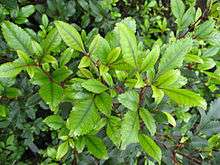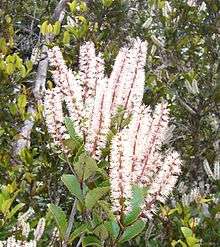Weinmannia racemosa
Weinmannia racemosa, commonly called kāmahi, is an evergreen small shrub to medium-sized tree of the family Cunoniaceae.[1] It is the most abundant forest tree in New Zealand,[2] occurring in lowland, montane, and subalpine forests and shrubland from the central North Island south to Stewart Island.
| Kāmahi | |
|---|---|
 | |
| Scientific classification | |
| Kingdom: | Plantae |
| Clade: | Tracheophytes |
| Clade: | Angiosperms |
| Clade: | Eudicots |
| Clade: | Rosids |
| Order: | Oxalidales |
| Family: | Cunoniaceae |
| Genus: | Weinmannia |
| Species: | W. racemosa |
| Binomial name | |
| Weinmannia racemosa L.f. | |

Description
Kāmahi bears racemes of small, pink or white flowers from July to January. Fruits are small capsules, 4–6 mm (0.16–0.24 in) long, ripening from October to May.[1] Kāmahi generally occurs with other broadleaf trees, at times acting as a pioneer species which is eventually succeeded by the southern beeches (Nothofagus spp.) or podocarps. It reaches 25 m (82 ft) or more in the Catlins of the south-eastern South Island. In forests to the west of the Southern Alps it codominates with southern rātā (Metrosideros umbellata) and black beech (N. solandri).[3] A closely related tree, tōwai or tawhero (W. silvicola), replaces kāmahi in the North Island north of latitude 38°S.[4]
Uses
The bark is very high in tannin, about 13%,[5] and was once exported for tanning. The inner bark was used as a laxative by Māori.[6] The wood has a tendency to warp or crack, so it is little used despite the tree's abundance.[2]
References
- de Lange, P. J. "New Zealand Plant Conservation Network". Retrieved 2013-11-22.
- Poole, A. L. "Kamahi - 1966 Encyclopedia of New Zealand". Retrieved 2007-06-19.
- "Land Care Research: Kāmahi-southern rata forest". Retrieved 2013-11-24.
- "Flora of New Zealand". Retrieved 2013-11-24.
- L.f. "Plants for a Future". Retrieved 2013-11-22.
- "Māori Plant Use". Retrieved 2013-11-22.
| Wikimedia Commons has media related to Weinmannia racemosa. |